西方建筑 英文版 Western Architecture简介
- 格式:ppt
- 大小:6.73 MB
- 文档页数:15
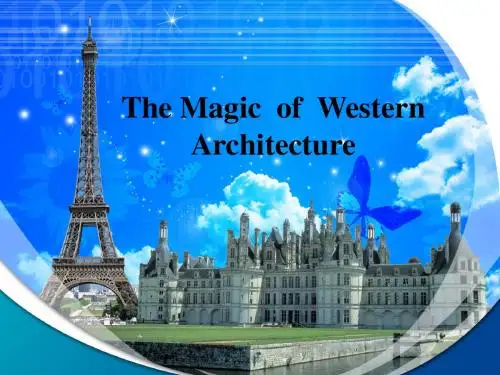
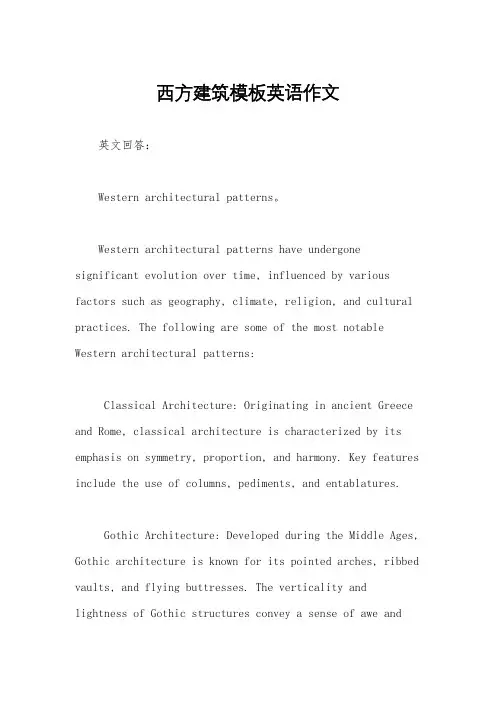
西方建筑模板英语作文英文回答:Western architectural patterns。
Western architectural patterns have undergone significant evolution over time, influenced by various factors such as geography, climate, religion, and cultural practices. The following are some of the most notable Western architectural patterns:Classical Architecture: Originating in ancient Greece and Rome, classical architecture is characterized by its emphasis on symmetry, proportion, and harmony. Key features include the use of columns, pediments, and entablatures.Gothic Architecture: Developed during the Middle Ages, Gothic architecture is known for its pointed arches, ribbed vaults, and flying buttresses. The verticality andlightness of Gothic structures convey a sense of awe andspirituality.Renaissance Architecture: Inspired by classical principles, Renaissance architecture emerged in Italy in the 15th century. It emphasizes harmony, symmetry, and the use of古典元素 such as columns, arches, and domes.Baroque Architecture: Baroque architecture, popular in the 17th and 18th centuries, is characterized by its elaborate ornamentation, dramatic curves, and lavish use of materials. It seeks to evoke a sense of grandeur and opulence.Neoclassicism: A revival of classical ideals, Neoclassicism emerged in the late 18th and early 19th centuries. It emphasized the use of simple geometric forms, clean lines, and restrained ornamentation.Modern Architecture: Developed in the early 20th century, Modern architecture emphasizes functionality, simplicity, and the use of new materials such as glass, steel, and concrete. It rejects traditional ornamentationand favors open, flowing spaces.Postmodern Architecture: A reaction to Modernism, Postmodern architecture emerged in the mid-20th century. It embraces diversity, eclecticism, and a playful use of historical and cultural references.Contemporary Architecture: Contemporary architecture encompasses a wide range of styles and approaches, often driven by technological advancements and sustainable design principles. It emphasizes innovation, experimentation, and a focus on the user experience.中文回答:西方建筑模板。

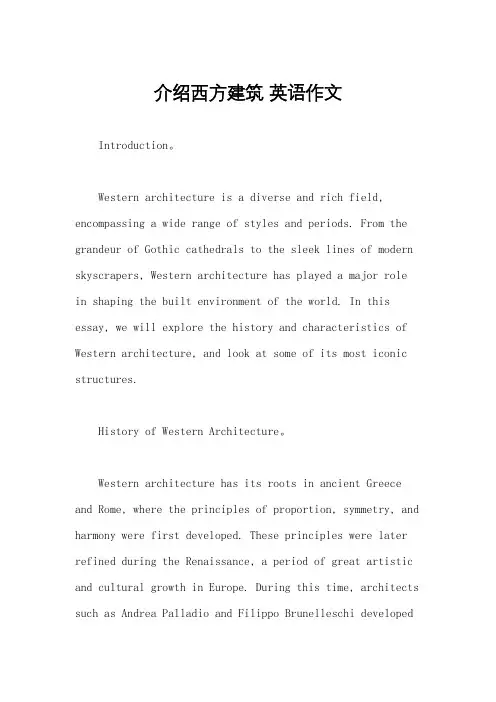
介绍西方建筑英语作文Introduction。
Western architecture is a diverse and rich field, encompassing a wide range of styles and periods. From the grandeur of Gothic cathedrals to the sleek lines of modern skyscrapers, Western architecture has played a major rolein shaping the built environment of the world. In this essay, we will explore the history and characteristics of Western architecture, and look at some of its most iconic structures.History of Western Architecture。
Western architecture has its roots in ancient Greece and Rome, where the principles of proportion, symmetry, and harmony were first developed. These principles were later refined during the Renaissance, a period of great artistic and cultural growth in Europe. During this time, architects such as Andrea Palladio and Filippo Brunelleschi developednew techniques for creating buildings that were both beautiful and functional.In the 18th and 19th centuries, Western architecture underwent a major transformation with the rise of the Industrial Revolution. New materials such as steel and concrete allowed for the construction of larger and more complex structures, while new technologies such as elevators and air conditioning made buildings more comfortable and efficient.In the 20th century, Western architecture continued to evolve with the rise of modernism. Architects such as Le Corbusier and Frank Lloyd Wright rejected the ornate styles of the past in favor of simple, functional designs that emphasized clean lines and geometric shapes. Today, Western architecture continues to be a vibrant and dynamic field, with architects pushing the boundaries of form and function in new and exciting ways.Characteristics of Western Architecture。

西方建筑欣赏介绍英文作文"英文,"When it comes to appreciating Western architecture, there's a rich tapestry of styles, histories, and influences to explore. From the grandeur of Gothic cathedrals to the sleek lines of modern skyscrapers, each building tells a story and reflects the cultural milieu of its time.Let's start with one of the most iconic styles in Western architecture: Gothic. The soaring spires, pointed arches, and intricate stone tracery of Gothic cathedrals, like Notre-Dame de Paris or Westminster Abbey, never fail to inspire awe. Walking through the dimly lit nave, with sunlight streaming through stained glass windows, you can't help but feel a sense of reverence and wonder. The Gothic style, with its emphasis on height and light, was not just about constructing buildings; it was about reaching towards the divine.Moving forward in time, we encounter the elegance of Renaissance architecture. Think of the symmetrical facades, domed roofs, and harmonious proportions of buildings like the Florence Cathedral or the St. Peter's Basilica in Vatican City. These structures embody the humanist ideals of balance, beauty, and rationality championed during the Renaissance period. Standing in front of the majestic dome of Florence Cathedral, designed by Brunelleschi, one can appreciate the ingenuity and skill of the architects ofthat era.Fast forward to the present day, and we find ourselves amidst the glass and steel jungle of modern architecture. Skyscrapers like the Empire State Building in New York or the Shard in London redefine our urban landscapes, pushing the boundaries of engineering and design. The sleek lines and futuristic forms of these buildings symbolize progress and innovation, reflecting the fast-paced nature of contemporary society.But it's not just the monumental structures thatcapture our imagination. Western architecture also encompasses charming townhouses, quaint cottages, and cozy cafes nestled along cobblestone streets. Whether it's the colorful facades of Amsterdam's canal houses or the charming balconies of Barcelona's Gothic Quarter, these smaller-scale buildings add character and warmth to their surroundings.In conclusion, Western architecture offers a diverse range of styles and influences, each with its own unique appeal. From the grandeur of Gothic cathedrals to the elegance of Renaissance palaces to the innovation of modern skyscrapers, there's something for everyone to appreciate and admire."中文,"谈到欣赏西方建筑,其中蕴含了丰富的风格、历史和影响。


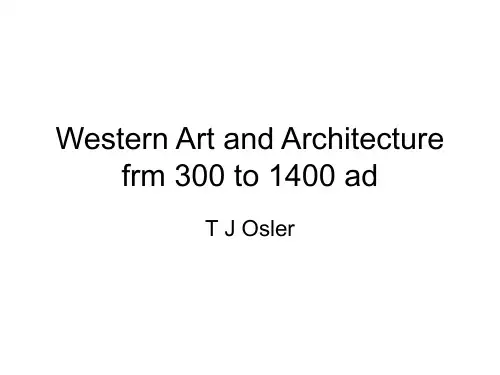
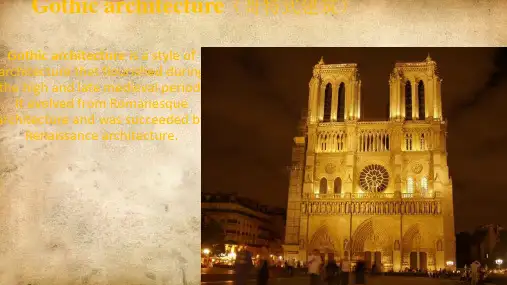
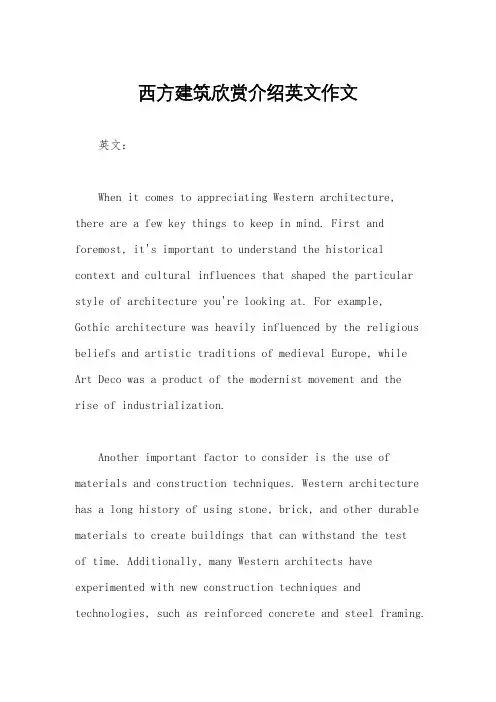
西方建筑欣赏介绍英文作文英文:When it comes to appreciating Western architecture,there are a few key things to keep in mind. First and foremost, it's important to understand the historical context and cultural influences that shaped the particular style of architecture you're looking at. For example,Gothic architecture was heavily influenced by the religious beliefs and artistic traditions of medieval Europe, whileArt Deco was a product of the modernist movement and therise of industrialization.Another important factor to consider is the use of materials and construction techniques. Western architecture has a long history of using stone, brick, and other durable materials to create buildings that can withstand the testof time. Additionally, many Western architects have experimented with new construction techniques and technologies, such as reinforced concrete and steel framing.Finally, it's important to appreciate the aesthetic qualities of Western architecture. From the grandeur of a Gothic cathedral to the sleek lines of a modernist skyscraper, Western architecture offers a wide range of styles and designs to admire. Whether you prefer the ornate details of a Baroque palace or the minimalist simplicity of a Bauhaus building, there's something for everyone to appreciate.中文:欣赏西方建筑,需要注意一些关键因素。

中西建筑对比英文简介作文英文:When it comes to architecture, there are many differences between Western and Chinese styles. Western architecture is often characterized by straight lines, sharp angles, and a focus on symmetry and proportion. Chinese architecture, on the other hand, tends to be more flowing and organic, with curved lines, sloping roofs, and an emphasis on harmony with nature.One of the most noticeable differences between Western and Chinese architecture is the use of color. Western buildings often feature muted, neutral tones, while Chinese buildings are often adorned with bright, vibrant colors. For example, the Forbidden City in Beijing is known for its intricate red and gold decorations, while the Palace of Versailles in France is predominantly white and gold.Another difference is the use of materials. Westernarchitecture often employs materials such as concrete, steel, and glass, while Chinese architecture makes use of wood, brick, and stone. This is partly due to the fact that wood is more readily available in China, but it also reflects a different cultural aesthetic.In terms of function, Western architecture tends to prioritize efficiency and practicality, while Chinese architecture often places more emphasis on symbolism and spiritual significance. For example, a Western office building might be designed to maximize productivity and comfort for workers, while a Chinese temple might be designed to align with the principles of feng shui and promote positive energy flow.Overall, both Western and Chinese architecture have their own unique strengths and weaknesses. Western architecture is often praised for its sleek, modern aesthetic and practicality, while Chinese architecture is admired for its rich cultural history and connection to nature.中文:当谈到建筑时,西方和中国的风格之间有许多差异。
Ancient Greek architectureIn Western culture, we commonly associate ancient Greek architecture with dramatic pillars in the front of a home or other building. Yes, it’s one of its features. Ancient Greek architecture dates to 400 BC. The style of architecture spread throughout other regions of the world and became popular in Europe in the mid-1700s. It commonly featured a front and back porch, which is where the columns were displayed. It is categorized by three different styles (also called orders). The three orders are known as the Doric, Ionic and Corinthian. The ancient Greek architectural style is significant because it promotes harmony and proportion in its design.Here are some picturesRoman architectureRoman architecture,which is famous for the symmetry of the building and the magnificent, is a continuation of ancient Greece architecture. Roman architecture is generally characterized by thick masonry walls, semi-circular arch, layer by layer to single out the door frame decoration and cross-vaulted structure. It reached its peak is in the 1~3 century when it achieved the peak of Western architecture. The Colosseum, its master work, was built in AD72-82.Now its Site is located on the Italian capital of Rome city center. For its history, it is a symbol of the ancient Roman civilization. It was round; but overlooking, it is oval.Byzantine architectureByzantine architecture is the building style of Constantinople after ad 330. Byzantine architects were compromise, at first drawing heavily on Roman temple features. Their combination of the basilica and symmetrical central-plan religious structures resulted in the characteristic Byzantine Greek-cross-plan church, with a square central mass and four arms of equal length. The most distinctive feature was the domed roof. Such structures have in common the predominance of a central domed space, flanked and partly sustained by smaller domes and half-domes spanning peripheral spaces.Gothic architectureGothic architecture is a style of architecture that flourished during the high and late medieval period. It dated back to 12th century in France and lasting into the 16th century, Gothic architecture was known during the period as “the French Style”, with the term Gothic first appearing during the latter part of the Renaissance.Its characteristic features include the pointed arch, and the flying buttress, stained windows.Rococo architectureRococo architecture was a variation of baroque. It began in the eighteenth century. It was lighter, more graceful, and more subdued than baroque architecture. Most of the rococo decorations were natural forms such as tree branches, clouds, flowers, sea shells, seaweed, and scrolls. Many colors that were used were pastels, but they also used lots of gold.Most rococo rooms were rectangular with rounded corners, and the walls were mostly flat, and smooth. Doors and woodwork had minor carvings. The often had decorations and gilding on the walls, doors, and draperies. Windows, wall panels, and doors often went all the way from the floor to the ceiling. Mirrors were also common.。
现代西式建筑英语作文Title: The Influence of Modern Western Architecture。
Modern Western architecture, characterized by its innovative designs and cutting-edge technologies, has significantly shaped the landscapes of cities around the world. This essay explores the profound impact of modern Western architecture on contemporary urban environments.Firstly, one cannot overlook the aesthetic appeal of modern Western architecture. Buildings such as the Guggenheim Museum in Bilbao, Spain, designed by Frank Gehry, and the Sydney Opera House in Australia, designed by Jørn Utzon, stand as iconic landmarks that attract millions of tourists annually. These structures showcase bold and imaginative designs that challenge traditional notions of architecture, drawing admiration and fascination frompeople worldwide.Moreover, modern Western architecture prioritizesfunctionality and sustainability. Architects utilize advanced materials and construction techniques to create buildings that are not only visually striking but also environmentally friendly and energy-efficient. For example, LEED-certified skyscrapers like the One World Trade Center in New York City incorporate features such as green roofs, solar panels, and efficient insulation, setting new standards for sustainable urban development.Furthermore, modern Western architecture fosters social interaction and community engagement. Public spaces integrated into architectural designs, such as parks, plazas, and pedestrian-friendly areas, promote connectivity and enhance the quality of urban life. The High Line in New York City, a repurposed elevated railway line transformed into a linear park, exemplifies how innovativearchitectural interventions can revitalize urban neighborhoods and create vibrant public realms.In addition, modern Western architecture embraces technological advancements to enhance the user experience. Smart buildings equipped with state-of-the-art amenitiesand digital infrastructure offer unparalleled convenience and comfort to occupants. From automated climate control systems to interactive interfaces, these buildings exemplify the seamless integration of technology into architectural design, redefining the way people interact with their built environment.Furthermore, modern Western architecture serves as a catalyst for economic development and urban regeneration. Iconic landmarks and architectural marvels become symbols of progress and innovation, attracting investment and driving tourism. Cities like Dubai and Singapore leverage iconic skyscrapers and futuristic cityscapes to position themselves as global hubs of commerce and tourism, harnessing the power of architecture to propel their growth and prosperity.In conclusion, modern Western architecture exerts a profound influence on contemporary urban environments, shaping the way we perceive, inhabit, and interact with our cities. Through innovative designs, sustainable practices, social integration, technological advancements, andeconomic revitalization, it not only transforms skylines but also enhances the quality of life for inhabitants worldwide. As we continue to embrace the principles of modern Western architecture, we embark on a journey towards more sustainable, inclusive, and resilient cities forfuture generations.。
介绍西方建筑英语作文Western architecture has a rich history that spans fromancient times to the modern era. It is characterized by a variety of styles, each with its own unique features and influences. Here is an essay that introduces Western architecture:Western Architecture: A Journey Through TimeWestern architecture is a testament to the ingenuity and creativity of human civilization. It has evolved through various periods, each leaving its indelible mark on the landscape of our built environment.Ancient Period: The BeginningsThe story of Western architecture begins with the ancient Greeks and Romans. The Greeks are known for their use of columns, which they employed in structures like the Parthenon, a temple dedicated to the goddess Athena. The Romans, on the other hand, were masters of engineering and introduced thearch and the dome, as seen in the Colosseum and the Pantheon. Medieval Period: Gothic and RomanesqueAs we move into the medieval period, we encounter theRomanesque and Gothic styles. Romanesque architecture is characterized by its massive walls, barrel vaults, and rounded arches, while Gothic architecture is known for its pointed arches, ribbed vaults, and flying buttresses, which allowed for taller and more open structures, such as the Notre-Dame Cathedral in Paris.Renaissance: A Revival of Classical IdealsThe Renaissance brought a revival of classical ideals. Architects like Brunelleschi and Michelangelo reintroduced the principles of symmetry, proportion, and harmony, which were evident in their designs for buildings like the Florence Cathedral and St. Peter's Basilica in Vatican City.Baroque and Rococo: Exuberance and EleganceThe Baroque and Rococo styles that followed were marked by their exuberance and elegance. Baroque architecture is known for its grandeur and dramatic use of light and shadow, as seen in the Palace of Versailles in France. Rococo, on the other hand, is characterized by its ornate decorations and playful asymmetry.Modern Era: Innovation and FunctionThe modern era of Western architecture began in the late 19th and early 20th centuries with the advent of new materials and technologies. Architects like Le Corbusier and Frank Lloyd Wright emphasized function and simplicity, creating buildings that were both practical and aesthetically pleasing, such asthe Villa Savoye and Fallingwater.Contemporary Architecture: Diversity and SustainabilityToday, Western architecture is characterized by its diversity and a focus on sustainability. Architects are exploring new materials, innovative designs, and eco-friendly practices, creating buildings that are not only visually striking but also environmentally responsible.In conclusion, Western architecture is a fascinating journey through time, reflecting the cultural, technological, and artistic changes of each era. It is a field that continues to evolve, with each new generation of architects adding their own unique contributions to the built environment.This essay provides a brief overview of the key periods and styles in Western architecture, highlighting the evolution of design and construction techniques from ancient times to the present day.。
介绍西方建筑英文作文Western architecture is characterized by its diverse styles and influences, ranging from classical Greek and Roman designs to modernist and postmodernist structures. The use of materials such as stone, glass, and steel allows for innovative and striking designs that stand out in urban landscapes.One of the most iconic features of Western architecture is the use of columns and arches, which can be seen in buildings such as the Parthenon in Greece and the Colosseum in Rome. These architectural elements not only provide structural support but also add a sense of grandeur and elegance to the overall design.In contrast to the ornate details of classical architecture, modern Western buildings often feature clean lines, minimalist designs, and large windows that allow for natural light to filter through. This emphasis onsimplicity and functionality reflects the shift towards amore contemporary aesthetic in architectural trends.Postmodern architecture, on the other hand, embraces eclecticism and experimentation, combining elements from different styles and time periods to create visually dynamic and unconventional buildings. This approach challenges traditional notions of form and function, pushing the boundaries of what is considered "good" design.Overall, Western architecture is a reflection of the cultural, historical, and technological advancements of the societies in which it emerges. From ancient temples to futuristic skyscrapers, each building tells a story of innovation, creativity, and the ever-evolving nature of architectural design.。
介绍西方建筑英语作文下载温馨提示:该文档是我店铺精心编制而成,希望大家下载以后,能够帮助大家解决实际的问题。
文档下载后可定制随意修改,请根据实际需要进行相应的调整和使用,谢谢!并且,本店铺为大家提供各种各样类型的实用资料,如教育随笔、日记赏析、句子摘抄、古诗大全、经典美文、话题作文、工作总结、词语解析、文案摘录、其他资料等等,如想了解不同资料格式和写法,敬请关注!Download tips: This document is carefully compiled by theeditor. I hope that after you download them,they can help yousolve practical problems. The document can be customized andmodified after downloading,please adjust and use it according toactual needs, thank you!In addition, our shop provides you with various types ofpractical materials,such as educational essays, diaryappreciation,sentence excerpts,ancient poems,classic articles,topic composition,work summary,word parsing,copyexcerpts,other materials and so on,want to know different data formats andwriting methods,please pay attention!Western architecture is a fascinating blend ofdifferent styles and influences. From ancient Greek and Roman architecture to modernist and postmodernist designs, Western architecture has evolved and adapted over the centuries.One characteristic of Western architecture is its emphasis on symmetry and proportion. Buildings are often designed with a sense of balance and harmony, with equal attention given to the arrangement of windows, doors, and other architectural elements. This creates a sense of order and elegance in the overall design.Another aspect of Western architecture is the use of different materials. Traditional Western buildings often feature stone or brick exteriors, which give them a solid and enduring appearance. In contrast, modernist buildings may incorporate materials like glass and steel, which create a sleek and contemporary look.Western architecture also embraces a wide range of architectural styles. From the grandeur of Gothiccathedrals to the simplicity of Bauhaus designs, there is a diversity of styles that reflect different periods and cultural influences. This diversity is what makes Western architecture so rich and interesting.In addition to its aesthetic qualities, Western architecture also serves practical purposes. Buildings are designed to provide shelter, comfort, and functionality. Whether it's a residential house or a commercial skyscraper, Western architects strive to create spaces that are notonly visually appealing but also meet the needs of the people who use them.Furthermore, Western architecture often incorporates elements of the natural environment. Buildings may be designed to take advantage of natural light, ventilation, and views. This integration of nature into the built environment creates a sense of harmony and connection with the surrounding landscape.Overall, Western architecture is a reflection of the cultural, historical, and technological developments of the Western world. It is a testament to human creativity and ingenuity, and it continues to inspire and influence architects around the world.。
西方建筑英文作文When it comes to Western architecture, one word that often comes to mind is "grandeur." Western architecture is known for its imposing and majestic structures that often leave people in awe. From the grand cathedrals of Europe to the towering skyscrapers of New York City, Western architecture has made a lasting impression on the world.The diversity of Western architecture is another aspect that sets it apart. From the classical columns and pediments of ancient Greece and Rome to the sleek lines and glass facades of modern buildings, Western architecture has evolved and adapted to different styles and influences over the centuries.One of the most iconic features of Western architecture is its attention to detail. From the intricate carvings on a Gothic cathedral to the ornate moldings and trimmings on a Victorian mansion, Western architecture is known for its meticulous craftsmanship and artistry.Western architecture has also been a reflection of the cultural and historical context in which it was created. The castles and fortresses of medieval Europe, for example, were built for defense and protection, while the grand palaces of the Renaissance were designed to showcase wealth and power.In recent years, there has been a renewed interest in preserving and restoring historic Western buildings. This focus on conservation and heritage has led to the revival of traditional building techniques and materials, as well as a greater appreciation for the architectural legacy of the past.In conclusion, Western architecture is a testament to human creativity, ingenuity, and craftsmanship. Its grandeur, diversity, attention to detail, and reflection of cultural and historical context make it a fascinating and enduring aspect of the built environment.。